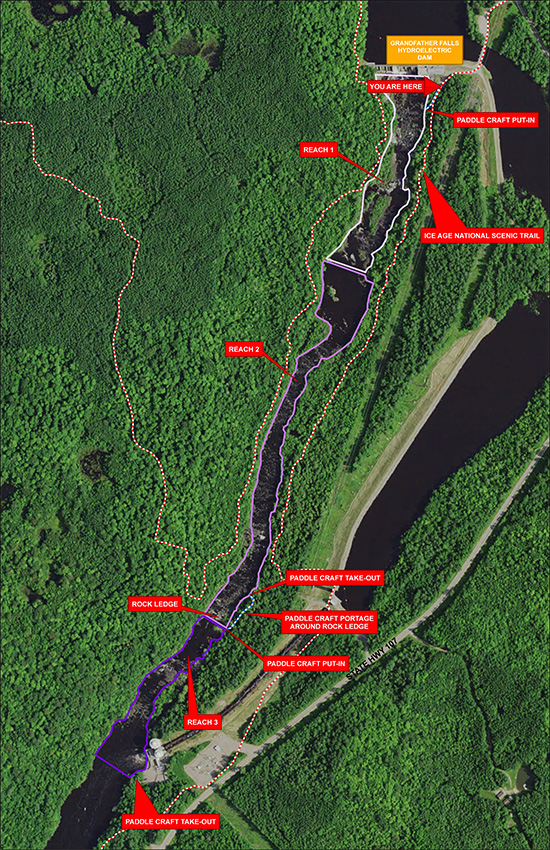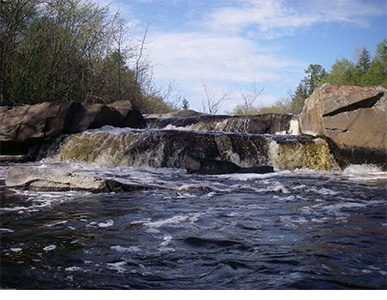Wisconsin Public Service owns and operates the Grandfather Falls hydroelectric project, Federal Energy Regulatory Commission (FERC)
Project No. 1966. The 17.24 megawatt project is located on the Wisconsin River in Lincoln County in north central Wisconsin.
On May 17, 2018, WPS received the FERC Order issuing a new license for the project that required
WPS to establish a recreation plan under Article 411. On Feb. 13, 2020, FERC approved
WPS's recreation plan, which includes three, four-hour scheduled whitewater flow
releases to be implemented each year.
This year, the release dates are:
- May 3, 2025 (1,800 cfs)
- May 17, 2025 (1,500 to 1,800 cfs)
- May 31, 2025 (1,500 to 1,800 cfs)
For each scheduled release, peak flows will start at approximately 10 a.m. and end at approximately 2 p.m.
Be safe. Make safety your highest priority while recreating near hydroelectric facilities by tracking the
current river flow status,
knowing the bypass reach area
and following these safety tips.
Updates regarding flow conditions and the status of scheduled flow events will be posted here as soon as available,
but no later than 12 p.m. on the day prior to scheduled releases.
Bypass reach area

The Grandfather Falls bypass reach extends approximately 4,500 feet downstream of the dam to the powerhouse tailrace.
The terrain is irregular and rugged, characterized by large boulders and bedrock outcrops interspersed with cobble.
The bypass consists of three relatively equal, 0.3 mile-long sections: reach one, reach two and reach three.
- Reach one (dam to large pool, Class II+ at flows of 1,800 cfs or less and Class II to III+ at flows of 2,000 cfs
or greater): Consists of two rapids that can be scouted from a rock outcrop along the Ice Age Trail on the east side of
the river. The first drop is a boulder garden with various options. The second rapid is also a boulder garden that leads
into a large pool.
- Reach two (large pool to major ledge, Class II to III+ at flows of 1,800 cfs or less and Class III+ to IV+ at
flows of 2,000 cfs or greater): Begins after the large pool. There are a few eddies and play opportunities before
the gradient eases as you approach the major ledge drop. At all flow levels, it is recommended that you take out
above the drop and scout. The drop is considered a Class IV to V+ at all flow levels. In the center, the flow goes
through a sizeable circulation, developing a hole that can have very powerful recirculation during higher flows or
become very deep with no good exit during lower flows.
- Reach three (major ledge to powerhouse, Class II+ to III at flows of 1,800 cfs or less and Class III to IV at
flows of 2,000 cfs or greater): Starts immediately downstream of the major ledge area and consists of some large
wave holes with play potential. There are a few more boulder gardens with a few eddies and a number of holes and
rock pour-overs before the gradient eases as you approach the powerhouse and take-out.
Whitewater rapids classifications

- Class I: Fast moving water with riffles and small waves. These rapids are easily passible for a novice, with clear channels and few obstructions.
- Class II: Straightforward rapids with wide, clear channels and waves up to three feet; occasional maneuvering may be required.
The upper end of this difficulty range is II+.
- Class III: Considered the upper limit of runnable rapids in an open canoe not equipped with whitewater outfitting.
These rapids are characterized by moderate to high, irregular waves, which are difficult to avoid, and may swamp an open canoe.
Complex maneuvering is required and small falls may be present. The best course may be hard to recognize; therefore,
scouting from the shore is necessary. Rapids at the lower and upper end of this difficulty range are designated
III- or III+, respectively.
- Class IV: Long, difficult and violent rapids, often with congested routes that are difficult to discern; therefore,
scouting from the shore is necessary. Rescue is often difficult. Precise boat maneuvering skills and whitewater outfitting is required.
- Class V: Rapids are characterized by very violent water, numerous obstructions or blind corners, steep drops and high,
irregular waves. Rescue is often difficult even for experts. A very reliable Eskimo roll, proper equipment, extensive
experience and practiced rescue skills are essential.